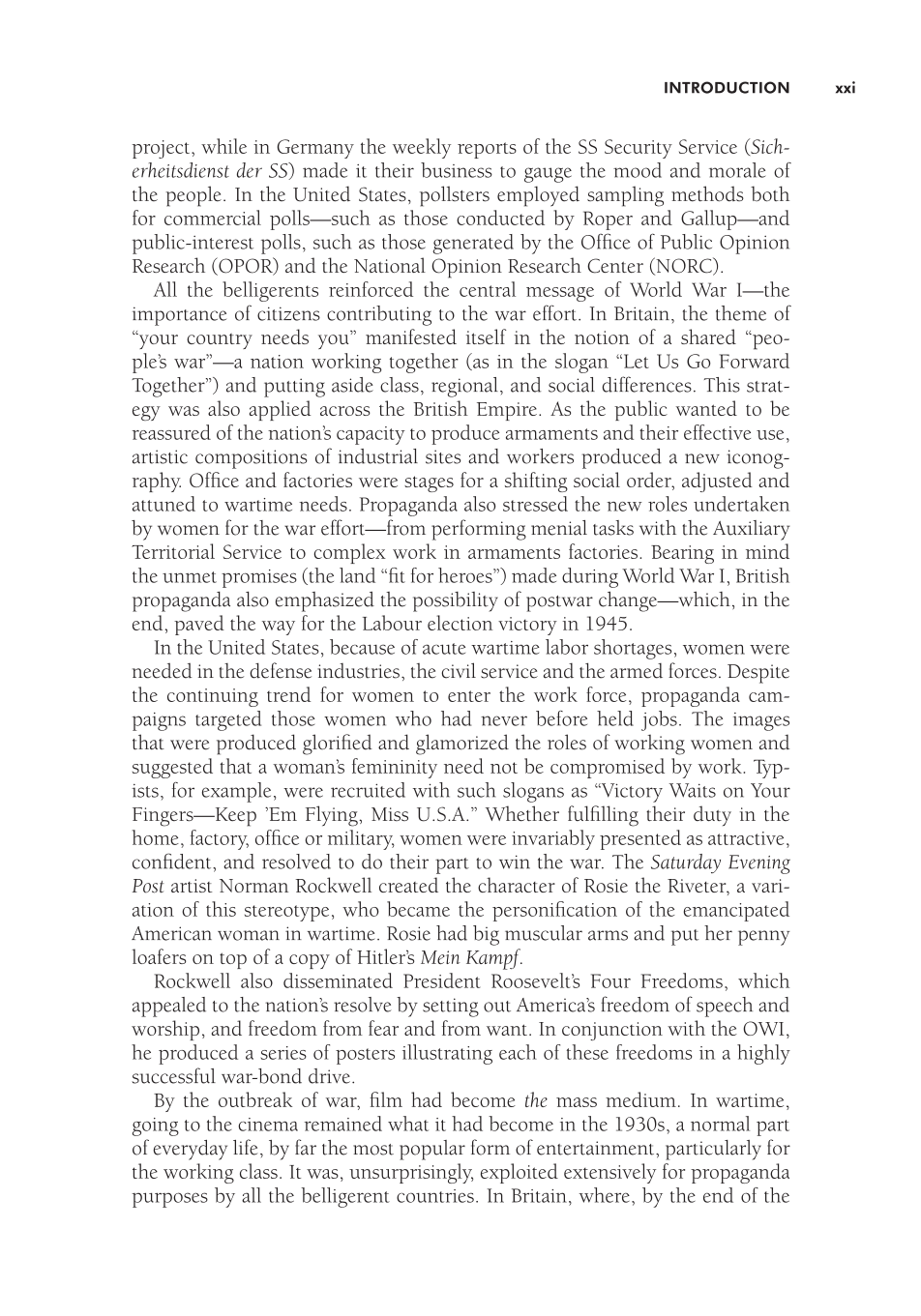Introduction xxi
project, while in Germany the weekly reports of the SS Security Service (Sich-
erheitsdienst der SS) made it their business to gauge the mood and morale of
the people. In the United States, pollsters employed sampling methods both
for commercial polls—such as those conducted by Roper and Gallup—and
public-interest polls, such as those generated by the Office of Public Opinion
Research (OPOR) and the National Opinion Research Center (NORC).
All the belligerents reinforced the central message of World War I—the
importance of citizens contributing to the war effort. In Britain, the theme of
“your country needs you” manifested itself in the notion of a shared “peo-
ple’s war”—a nation working together (as in the slogan “Let Us Go Forward
Together”) and putting aside class, regional, and social differences. This strat-
egy was also applied across the British Empire. As the public wanted to be
reassured of the nation’s capacity to produce armaments and their effective use,
artistic compositions of industrial sites and workers produced a new iconog-
raphy. Office and factories were stages for a shifting social order, adjusted and
attuned to wartime needs. Propaganda also stressed the new roles undertaken
by women for the war effort—from performing menial tasks with the Auxiliary
Territorial Service to complex work in armaments factories. Bearing in mind
the unmet promises (the land “fit for heroes”) made during World War I, British
propaganda also emphasized the possibility of postwar change—which, in the
end, paved the way for the Labour election victory in 1945.
In the United States, because of acute wartime labor shortages, women were
needed in the defense industries, the civil service and the armed forces. Despite
the continuing trend for women to enter the work force, propaganda cam-
paigns targeted those women who had never before held jobs. The images
that were produced glorified and glamorized the roles of working women and
suggested that a woman’s femininity need not be compromised by work. Typ-
ists, for example, were recruited with such slogans as “Victory Waits on Your
Fingers—Keep ’Em Flying, Miss U.S.A.” Whether fulfilling their duty in the
home, factory, office or military, women were invariably presented as attractive,
confident, and resolved to do their part to win the war. The Saturday Evening
Post artist Norman Rockwell created the character of Rosie the Riveter, a vari-
ation of this stereotype, who became the personification of the emancipated
American woman in wartime. Rosie had big muscular arms and put her penny
loafers on top of a copy of Hitler’s Mein Kampf.
Rockwell also disseminated President Roosevelt’s Four Freedoms, which
appealed to the nation’s resolve by setting out America’s freedom of speech and
worship, and freedom from fear and from want. In conjunction with the OWI,
he produced a series of posters illustrating each of these freedoms in a highly
successful war-bond drive.
By the outbreak of war, film had become the mass medium. In wartime,
going to the cinema remained what it had become in the 1930s, a normal part
of everyday life, by far the most popular form of entertainment, particularly for
the working class. It was, unsurprisingly, exploited extensively for propaganda
purposes by all the belligerent countries. In Britain, where, by the end of the






























































































































































































































